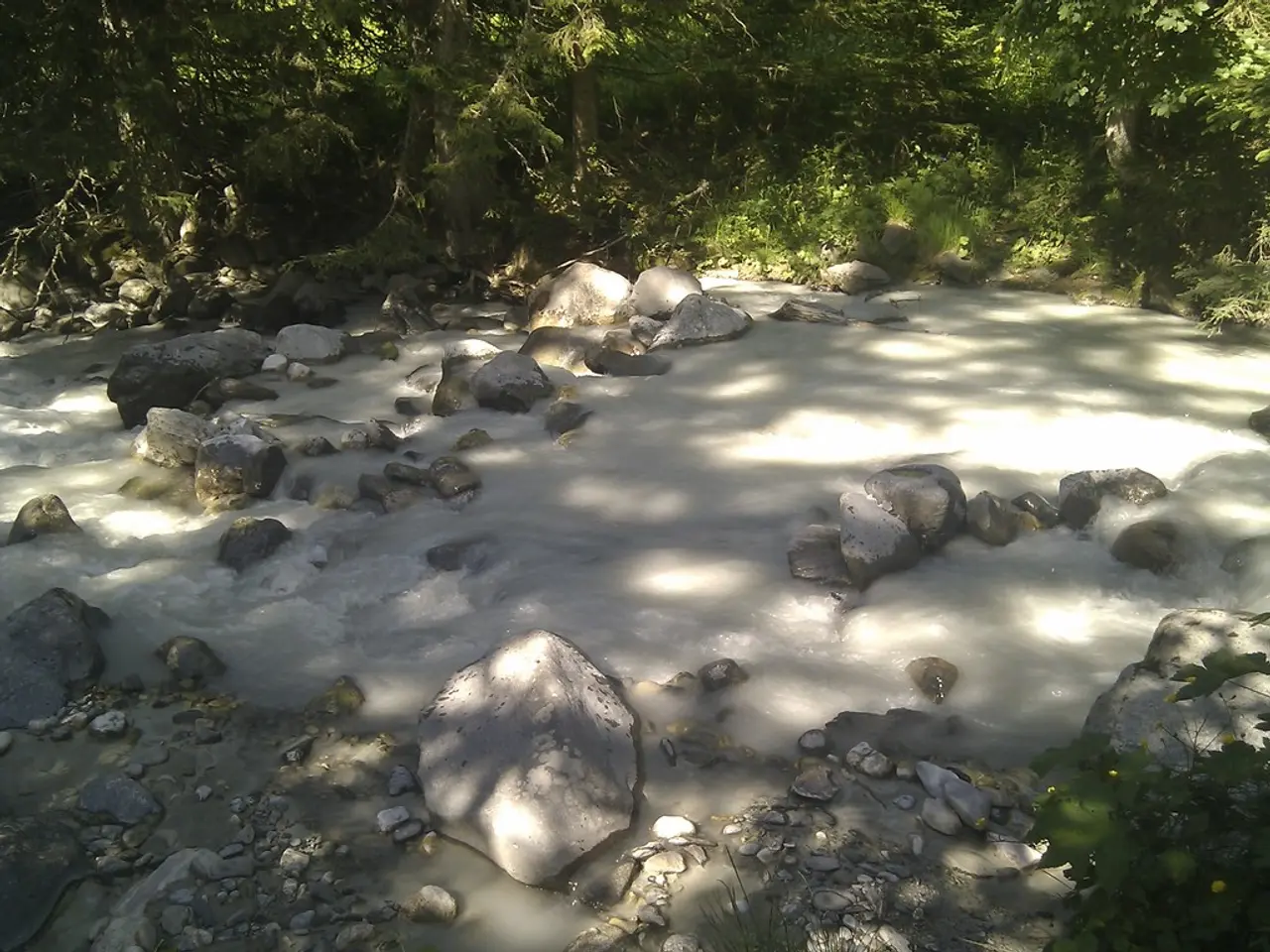Runoff from Abandoned Mining Operations
In areas where mining activities have been abandoned, a common environmental concern is the issue of acid mine drainage (AMD). This form of water pollution, characterised by highly acidic water rich in heavy metals, poses a significant threat to water quality [1][2].
The Pennsylvania Department of Environmental Protection's Abandoned Mine Reclamation site offers valuable resources for those seeking to understand the chemistry of AMD and explore passive treatment options. These methods, including constructed wetlands, limestone drains, and anaerobic bioreactors, harness natural processes to neutralise acidity, precipitate metals, and promote biological activity [3].
Constructed wetlands function by allowing AMD water to flow through vegetation and substrates, where microbial and plant processes increase pH and remove metals by precipitation and adsorption. Limestone drains use alkaline limestone material to raise the pH of acidic water through dissolution of calcium carbonate, promoting metal precipitation as hydroxides or carbonates [1][2][3]. Anaerobic bioreactors stimulate sulfate-reducing bacteria that reduce sulfate to sulfide, which then precipitates metals as metal sulfides, while also generating alkalinity to neutralise acidity [1][2][3].
These treatments rely on chemical processes such as calcium carbonate (limestone) dissolution, which consumes acidity and raises pH, and sulfate-reducing bacterial activity producing sulfide ions, which precipitate metals as insoluble metal sulfides [1][3][5]. Precipitation of metal hydroxides or carbonates also occurs once pH rises, thereby removing toxic metals from solution [1][5].
These passive methods are advantageous due to their sustainability, minimal energy input, and suitability for remote or legacy mines, although they typically require larger areas and longer timescales than active chemical treatments [1][3].
The Environmental Protection Agency (EPA) has also played a crucial role in addressing AMD. The EPA's "Acid Mine Drainage Prediction" (1994) and "Abandoned Mine Site Characterization and Cleanup Handbook" (2000) provide technical documents and resources for project managers working to address the environmental concerns posed by inactive mines and mineral processing sites [4][6].
Moreover, the EPA's "Prevention of Acid Mine Drainage Generation from Open-pit Highwalls-Final Report" (2005) summarises the results of performance data on the ability of four technologies to prevent the generation of AMD from an open-pit highwall [7].
The U.S. Department of Interior's Office of Surface Mining also offers resources, references, and funding information for state and tribal professionals addressing surface mining issues [8].
The EPA's "319 Grants Across the Country: Water Quality Improvements" initiative aims to address water quality issues, including AMD, through funding and partnerships [9].
It is essential to note that the resulting fluids may be highly toxic and, when mixed with groundwater, surface water, and soil, may have harmful effects on humans, animals, and plants [1]. Heavy metals can be leached from rocks that come in contact with the acid, a process that may be substantially enhanced by bacterial action [10].
In conclusion, understanding and addressing AMD is crucial for preserving our environment and ensuring the safety of our communities. The resources and information available from organisations such as the Pennsylvania Department of Environmental Protection, the EPA, and the U.S. Department of Interior provide valuable guidance for those seeking to combat this issue.
- In the realm of abandoned mining sites, surface water often becomes contaminated due to acid mine drainage (AMD), a form of water pollution.
- AMD, characterized by highly acidic water rich in heavy metals, poses a significant hazard to water quality, as documented by studies [1][2].
- The Pennsylvania Department of Environmental Protection's Abandoned Mine Reclamation site provides resources for understanding the chemistry of AMD and exploring passive treatment methods.
- Passive treatment methods, such as constructed wetlands, limestone drains, and anaerobic bioreactors, utilize natural processes to neutralize acidity, precipitate metals, and promote biological activity.
- Constructed wetlands work by allowing AMD water to flow through vegetation and substrates, resulting in increased pH and metal removal.
- Limestone drains use alkaline limestone material to raise the pH of acidic water, promoting metal precipitation as hydroxides or carbonates.
- Anaerobic bioreactors stimulate sulfate-reducing bacteria that reduce sulfate to sulfide, which then precipitates metals as metal sulfides and generates alkalinity.
- These treatments rely on chemical processes like calcium carbonate dissolution and sulfate-reducing bacterial activity to neutralize acidity and remove toxic metals.
- Precipitation of metal hydroxides or carbonates occurs when pH rises, eliminating toxic metals from solution.
- These passive methods have advantages, such as sustainability, minimal energy input, and suitability for remote or legacy mines, but they typically require larger areas and longer timescales than active chemical treatments.
- The Environmental Protection Agency (EPA) has contributed significantly to addressing AMD through technical documents, such as the "Acid Mine Drainage Prediction" (1994) and the "Abandoned Mine Site Characterization and Cleanup Handbook" (2000).
- The EPA's "Prevention of Acid Mine Drainage Generation from Open-pit Highwalls-Final Report" (2005) offers insights into the performance of technologies designed to prevent AMD generation.
- The U.S. Department of Interior's Office of Surface Mining provides resources, references, and funding information for professionals addressing surface mining issues.
- The EPA's "319 Grants Across the Country: Water Quality Improvements" initiative seeks to address water quality issues like AMD through funding and partnerships.




